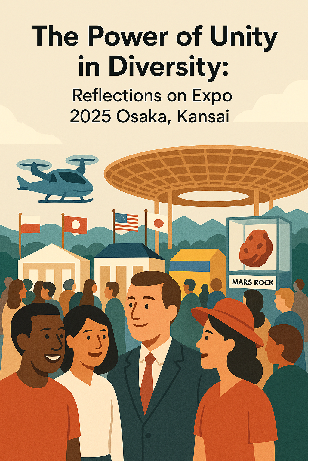
April 13, 2025
In an age where the internet allows us to explore the world from the palm of our hands, one might ask—what is the true value of a physical world expo today? The answer lies not only in what we see, but in what we experience together.
Today, April 13, marks the grand opening of Expo 2025 Osaka, Kansai, a spectacular 184-day celebration of innovation, culture, and global collaboration. This is only the third large-scale world expo to be hosted in Japan, following the trailblazing Osaka Expo in 1970 and the environmentally focused Aichi Expo in 2005.
With participation from 158 countries and regions and 84 pavilions spread over a massive 155-hectare venue—equivalent to 33 Tokyo Domes—the expo offers more than just exhibitions. It presents a shared vision for the future.
Visitors can witness the cutting-edge of science and technology, such as a beating heart grown from iPS cells or ride in a simulated “flying car,” one of the potential next steps in mobility. Japan’s own pavilion features a rare meteorite from Mars, while the U.S. pavilion echoes history by exhibiting a moon rock, recalling the excitement of the 1970 Expo.
At the heart of the venue lies the world’s largest wooden structure: a 2-kilometer circular roof—known as the “Grand Roof”—under which 57 international pavilions are gathered. This design is symbolic of the expo’s theme: “Designing Future Society for Our Lives.” But more profoundly, the structure conveys a powerful message: “Unity in Diversity.”
Unlike the limitless, virtual connections of the internet, the expo creates a physical space where people from around the world can meet, interact, and exchange ideas face-to-face. It reminds us that while digital tools can inform us, real encounters can transform us.
In a time marked by both global collaboration and conflict—such as the inclusion of Ukraine and the absence of Russia—Expo 2025 stands as a hopeful testament to what humanity can achieve when we come together with mutual respect and curiosity.
So for those visiting Japan this year, don’t just explore it online—step into the future, in real life, at Expo 2025 Osaka, Kansai.
多様性の中の一体感の力――大阪・関西万博2025を通して考える
スマートフォンひとつで世界のあらゆる場所の様子が見られる今の時代において、物理的な「万博」の価値とは何でしょうか? その答えは、私たちが「何を目にするか」だけでなく、「共に体験すること」にあるのかもしれません。
本日、4月13日、大阪・関西万博2025が開幕しました。184日間にわたり、イノベーション、文化、そして世界的な協力を祝う壮大な祭典が繰り広げられます。これは、日本で開催される3度目の大規模な万博であり、1970年の大阪万博、2005年の愛知万博に続くものです。
158の国と地域が参加し、合計84のパビリオンが並ぶ会場は、約155ヘクタール――東京ドーム33個分に相当する広さです。そこには展示以上の価値があります。ここでは、未来への共有ビジョンが示されているのです。
訪れる人々は、iPS細胞から作られた拍動する心臓や、「空飛ぶクルマ」の体験といった、最先端の科学技術に触れることができます。日本館では「火星の石」とされる隕石が展示され、アメリカ館では1970年の万博でも話題となった「月の石」が再び来場者の目を引きます。
会場の中心には、世界最大の木造建築である「大屋根リング(Grand Roof)」が設けられています。この直径2キロに及ぶ大きな屋根の下に、57の海外パビリオンが集められています。この設計は、万博のテーマである「いのち輝く未来社会のデザイン」だけでなく、「多様でありながら、ひとつである」という力強いメッセージを表しています。
インターネットの無限のつながりとは異なり、万博は、世界中の人々が実際に出会い、対話し、アイデアを交換する場です。デジタルの世界が私たちに「情報」を届けるのに対し、リアルな出会いは私たちに「変化」をもたらします。
国際的な協調と同時に対立の存在もある時代――たとえば、ウクライナは参加していますが、ロシアは不参加です――この万博は、相互の尊重と好奇心をもって共に集まることで、人類が達成できる可能性を希望として示しています。
もし、今年日本を訪れる機会があるなら、インターネットで見るだけでなく、リアルな未来を体験してみてください。大阪・関西万博2025で。
